This past November, the Labriola National American Indian Data Center hosted a plethora of events for Native American Heritage Month to celebrate the diversity within our Indigenous communities and provide support and resources to American Indian students attending Arizona State University. Our events covered an array of programs including performing arts, dance, deejays, jewelry making, running, and film screenings. The following is a summary of each event that took place for this year’s Native American Heritage Month, beginning with the perspectives of two of our student workers, Utohna Francis (Diné) and Kamalani Welch (Colorado River Indian Tribes).
“What Native American History Month Means to Me” by Kamalani Welch (Colorado River Indian Tribes)
Greetings everyone, my name is Kamalani Welch and I am one of the student workers at Labriola. It is Native American History Month! As this month is coming to an end, I’d like to reflect on the highlights that I’ve encountered this month and what this month means to me. I’m always so proud and thankful during this month because it shines a light on indigenous people and our history, being able to learn from not only my elders and my own Tribes history but also my colleagues and their own history. For Native American History Month I’ve made it a ritual to always go on one hike and sit down and embrace everything that I see and feel. This month I was able to hike up one of the mountains on my reservation with my auntie and we were able to talk about the history of one of our mountains.
Labriola holds multiple events during this month and I have been able to attend a couple of these. One of my favorite events was watching the film, “Powerlands.” This film highlights the displacements that occur in Indigenous communities due to the devastation of the environment by large corporations. This film was very moving and I chose to do more research on my Tribes and how our land has been affected by large agricultural corporations that have affected the land. As this month is nearing its end, I advise all of us to continue our knowledge regarding our histories and continue to be proud of who we are. Thank you!
“What made NAHM Memorable?” By Utohna Francis (Diné/Navajo)
Native American Heritage Month is celebrated for the recognition of Indigneous people past and present. Rededicating ourselves to honor tribal sovereignty, promoting tribal self-determination, and upholding the United States’ trust and treaty responsibilities to tribal nations.
I attended Labriola’s Jewelry Making Workshop the first week of November and it’s my most memorable experience I had this past month. Growing up, I’ve always wanted to learn more about the process of making jewelry, probably because I had an interest in the art of silversmithing, something I’ve come across multiple times on my reservation. This experience of working with jewelry engaged me to create something out of my imagination, motivating me to possibly pursue silversmith in the future.
The importance of NAHM to me is that there is a sense of community that feels stronger than usual. There’s nothing more comforting than seeing Natives from all different tribes of the world come together sharing stories, teachings and expressing their Native languages.
To celebrate Native American Heritage Month, here are some actions you can take to support our communities: learn who’s land/reservation you’re on, shop from Indigenous-owned and local businesses, learn and respect Native cultures, and for my fellow Indigenous peers, decolonize.
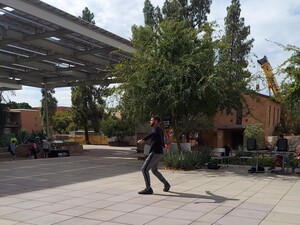
Tuesday, November 1st, Native American Heritage Month Kickoff
From 10am to 2pm, the Labriola National American Indian Data Center hosted a kickoff for Native American Heritage Month. The kickoff featured two Indigenous dancers, Madeline Gishey (Diné), a traditional jingle dancer, and Richard Bullard, a current Indigenous student at Arizona State University and contemporary break dancer. Alliance of Indigenous People attended as well and supplied foods that nurtured the hungry bellies of the dancers and attendees. Alliance of Indgenous Peoples is a student-led alliance at Arizona State University that serves to represent and unify any and all self-identifying Indigenous voices on campus in an effort to ensure that all students are provided appropriate resources and support to develop into holistic Indigenous leaders. We also had a small book display that featured essential topics and reads from our collection, such as Vina Deloria’s “Custer Died for Your Sins'' and Joy Harjo’s “Poet Warrior.” You can find these titles in our Open Stacks on the second floor of Hayden Library.
Wednesday, November 2nd, Jewelry Making with Makerspace
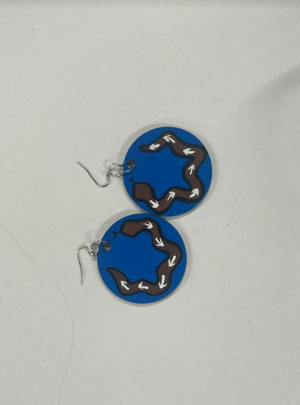
On Wednesday, November 2nd, the Labriola Center partnered with Makerspace to create an event that focused on land acknowledgement, Indigenous-centered symbols, and the resources at Hayden Library available to students to create pendants, earrings, and charms using Makerspaces’ laser cutter. Yitazba, Program Coordinator for Labriola at West campus, worked with Alexia Lopez Klein, the Program Coordinator at Tempe Makerspace, in developing culturally appropriate materials that were accessible to non-Indigenous participants, such as cacti, spiders and flower charms, as well as pendants and charms that were specifically for O'odham community members, such as the original names of the mountains surrounding the greater Phoenix area. This event was a hit, with a full registration of almost 30 people, with several patrons who commented on how happy they were that this event was made possible.
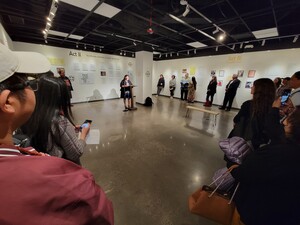
Wednesday, November 9th, Jean Chaudhuri Archive Exhibit Reception
“We survive, we persist. And it's not because we have not struggled.” - Jonodev Chaudhuri
The rain clouds that passed over the valley did not deter me from the bright inner light I felt at finally arriving upon the date of Jean Chaudhuri’s exhibit at ASU West campus. The droplets that scattered across the sky gave sustenance to my wonder at being at Labriola. After months of planning, meetings across several departments, and organizing, we finally achieved an evening where we could honor the incredible work of Jean Chaudhuri, a woman who is recognized by many leaders within Indian Country, but largely unknown to the greater public.
Indigenous women have faced numerous tribulations throughout history. For most tribes, the women are leaders within their community, and for Jean Chaudhuri, this status was not unfamiliar to her. Jean Chaudhuri was a woman well before her time. She was born in 1937 in Oklahoma and was a member of the Muscogee Nation. She ran away from boarding school eight times, and seven out of those eight times she was chased by dogs, captured, humiliated, beaten, and isolated by the boarding school teachers and faculty. However, on the eighth try, her persistence and determination brought her home. She ran almost sixty miles on foot to escape her boarding school. This bright inner fire and compassion for herself as an Indigenous person reigned outward onto every Native community she encountered. She made it her life goal to make the world a better place for Indigenous peoples. Jean knew suffering and that being alive today as an Indigenous person is not only a miracle, but a gift of bravery from our ancestors who persisted as she did before us, when she ran the miles from violence towards a better life.
Early on in life, Jean developed a deep love for helping her community. She moved to Tucson, Arizona in 1972, where she founded the first Indian health clinic. The health clinic was the first of its kind to be within a city, rather than on the reservation, as there were many Indigenous peoples who relocated into urban areas, such as Tucson, for work. During her time in Tucson, Jean was Director of the Tucson Indian Center and Traditional Indian Alliance. The center was dedicated to helping individuals with alcoholism while the Traditional Indian Alliance provided culturally sensitive American Indian mental health programs that addressed health and social welfare issues which plagued American Indians. She later moved to Phoenix, Arizona in 1985, where she established the Native American Heritage Preservation Coalition a year later in 1986. The Native American Heritage Coalition's purpose was to educate the general public and legislatures on the importance of preserving Native American cultural identity and history. As director, she fought against the land swap of the Phoenix Indian School. Although the school’s establishment was seeped in trauma and resulted in the heinous deaths of many American Indian children, Jean was determined that the site be a source of healing, rather than another example of genocide and erased history. She was angered that a private company sought to build luxury homes over the bones of Native children who were buried at the school in unmarked graves. She was angered that the community did not see the possibility in making something so tragic and horrific into something beautiful and celebratory of Indigenous peoples. So, like she had done before with her own experience in boarding school, Jean made swift and avid movements towards preventing the land swap. Despite all odds, she succeeded. Without Jean Chaudhuri, the Phoenix Indian School would not be standing here today.
When I first encountered Jean Chaudhuri’s collection, I was faced with boxes of papers scattered across several dark wooden desks. The surmounting piles of documents daunted me. I did not know where to begin. However, Vina Begay, the archival librarian at Labriola National American Indian Data Center, gave me instructions and insight on how to approach the collection in a way that was honorable to Jean and highlighted incredible work she had done in her lifetime. Vina treats archives with respect, as they are imprints of people and times before us and they should be treated as such. With Jean, she chose a storytelling method because that’s who Jean was. Jean Chaudhuri was not only a great public speaker, an advocate for American Indian tribes, and a prolific leader, but she was also a poet, an author, and a playwright. Through Vina’s instruction, I got to know Jean Chuadhuri as a person rather than a mere archive collection. This archive collection is symbiotic with Jean’s visions and thoughts, her tribulations and her doubts. I am honored to have helped Vina with this archive and I am honored to have met her family and gotten to know Jean.
-Written by Yitazba Largo-Anderson (Diné)
Thursday, November 17th, Lofi Study with DJ Acro
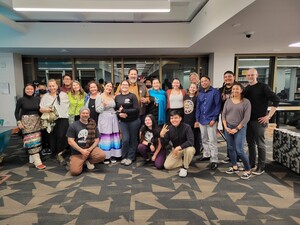
On Thursday, November 17, the Labriola hosted their annual Lo-Fi Study session at the Labriola Center at Hayden and at Fletcher library, the Labriola live streamed the set for their Beats and Beading event. The session was DJed by Hopi beat maker Zayvian Kewanwytewa, also known as Acro. Acro’s roots are based in Second Mesa and he travels back and forth between his hometown and South Phoenix. In addition, students at Hayden enjoyed the chill vibes the music provided and the environment it fostered for studying. As the 3 hour set moved into its last hour, the Maori from the previous event stopped by for a visit. During their visit, they were able to socialize with ASU students, sharing cultural knowledge and learning more about each other, and they also learned more about the Labriola’s programing and open stacks collection. By the end of the night, the 2nd floor was alive with music, conversation, and laughter. It was a night of community making.
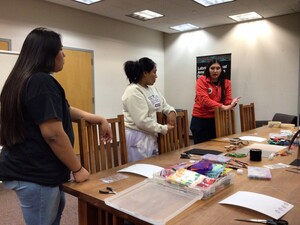
Thursday, November 17th, Beats and Beading Streaming Lofi Study Session
During the lofi study session at the Labriola Center at Hayden Library, Fletcher library live streamed the Hopi beat maker Acro. Acro’s love of music and creating beats sparked in 8th grade. Continuing his journey, he played professionally as a lofi hip hop artist in 2019 and with encouragement from his fellow artist friends and local beatmakers, Acro has performed at shows and events and had the chance to play live in 2020.
During the live stream, Acro played genres like City Pop and Studio Ghibli, which stem from Tokyo, Japan. City Pop formulated in the mid 1970’s, which reflected vivid images of life in cosmopolitan Tokyo. Studio Ghibli stemmed from Joe Hisaishi’s whimsical tracks on hit films like Howl’s Moving Castle, Spirited Away, and Princess Mononoke. Students from the Beats and Beading Event commented on how excited they were to hear Acro playing music from those genres. The livestream video focused on Acro’s beat machine, which glowed neon embers throughout the session when he pressed on the pads, reminding me of a phosphorescent turtle shell. It was peaceful to watch Acro’s hands press the various buttons, each one conducting sound and lyric. The music was loud and clear, and extremely soothing to listen to, especially during finals season and a busy month at Labriola.
Sprinkled across the tables near the open stacks at Labriola West campus were beading needles, rainbows of seed beads, sparkling faux leather, nylon thread, shining cabochons, and bead backing, which is a thick fabric used to hold the shape you want while embroidering your beads. Baylee LaCompte (Hunkpapa/Sicangu Lakota), a new student worker at the Labriola, led the session. She gave a history lesson on beading, noting how beads were traded with eastern tribes between Europeans while the Southwest tribes were silversmiths, also through trade with the Spaniards and their silver dollars. Tribes have traded amongst ourselves for millenia, and once this new material (silver and glass) was introduced, we took it upon ourselves to create and master this art that reflected our values, teachings, and lessons in the form of jewelry.
It was humbling to learn from Baylee, as she is an avid beader and seamstress of ribbon skirts (made with pockets!). She sells mostly from her instagram, @balianbeautycreationz and has a TikTok account in her bio that documents her art. At the end of the session, everyone created a beaded piece of art. One student worker from AISSS, Lilly, completed a keychain with a rainbow. It was an excellent evening learning about the history of beading while also listening to some incredible beat music from DJ Acro.
-Written by Yitazba Largo-Anderson (Diné)
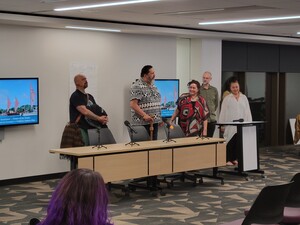
Tuesday, November 15th, Intercultural Well-Being Gathering
The Labriola Center hosted the Intercultural Well-Being gathering with the Food Justice Research Group at ASU. The day began with traditional Maori songs and a blessing. The event invited Maori scholars and practitioners from Aotearoa to share their approaches to well-being that centered their Indigenous knowledge and practices with the purpose of healing and supporting cultural resilience. Over the course of 4 workshops, the Maori focused on a different topic related to well-being. These workshops included Weaving Intercultural Well-being into Economic Thinking, Food Systems and Seed Sovereignty, Design, Art, and Innovation in Well-being, and Movement Activation and Well-being. In each workshop, attendees were encouraged to think critically about well-being in regards to Indigenous peoples and the larger society. In addition to the workshops, in the evening, participants were treated to Indigenous snacks and teas provided by local Indigenous vendors. Everyone gathered just outside the Welcome Wall and concourse level to drink Indigenous teas and snacks from Indigenous vendors, Sconeon, Blue Corn Custom Designs, and Blue Naadą́ą́' Sweets. To end the day, the Maori provided a closing plenary session and a blessing. Participants shared that this event was vitally important to their continued understanding of critically engaging environmental issues that center Indigenous issues and experiences.
-Written by Eric Hardy (Diné)
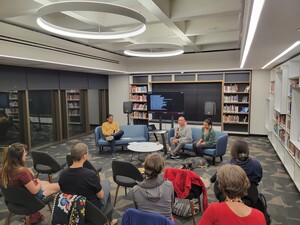
Friday, November 18th, Run to Be Visible: Film Screening and Q&A
The following day, the Labriola hosted Dr. Lydia Jennings (Yoeme & Wixárika), Postdoctoral Fellow in Community, Environment and Policy at the University of Arizona, for a film screening and panel discussion of her film Run to Be Visible. The film brings attention to challenges Indigenous people face and overcome while pursuing STEM degrees in higher education, while also bringing attention to the negative impacts mining has on Indigenous communities and the environment through running. Lydia shared her journey of training to run 50 miles and how running was a vital part of how she was able to complete her doctoral studies. She also discussed that during her training, she thought of all the other Indigenous students and doctors who struggle with higher education, and wanted to highlight all their accomplishments. One of those doctors joined her during the panel discussion. Dr. Darryl Reano (Acoma), assistant professor in the School of Earth and Space Exploration, and Dr. Jennings shared their struggles with higher education and how they were able to overcome those challenges to complete their programs. Additionally, both shared personal experiences with the audience and stories of resilience.
-Written by Eric Hardy (Diné)
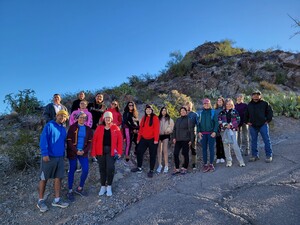
Saturday, November 19th, Knowledge from the Land
After the film screen, the next morning, the Labriola hosted their annual Knowledge from the Land event. These events are a place where local Indigneous community members can share their knowledge of the land and history. Often these voices are ignored and not given space to be shared with larger communities. For this event, Jacob Butler (Salt River Pima-Maricopa Indian Community) provided a walking tour of the Tempe Town Lake area. During his tour, he shared how Tempe became Tempe and the role O’otham played. More importantly, he shared the negative impacts that Tempe has brought to his people and community. He shared that Tempe Town Lake is an illusion, and that none of the lake’s landscape is natural to this area and that the lake is considered, by many from his community, a swamp. Additionally, he shared some history of “A” mountain and how, because it's considered a tourist attraction, it limits access to cultural sites of the O’otham. Jacob was clear and honest with what he shared, and he stated the reason why he is honest is because he wants folks to know the history from his community, as it’s part of Tempe’s history too. Afterwards, many participants shared they didn’t know of any of the history Jacob shared and were grateful for the opportunity to learn more.
-Written by Eric Hardy (Diné)
Tuesday, November 22nd, 100 Years Film Screening
To end the month, the Labriola Center and American Indian Support Services (AISSS) at Fletcher Library showed a film screening of “100 Years: One Woman’s Fight For Justice,” which documents Elouise Cobell’s lawsuit against the Federal Government. Over one-hundred years ago, the federal government allotted lands to 300,000 Native peoples so that the individuals would sell their land off rather than have community “ownership” over their reservations. The federal government promised Native families that they would distribute revenues generated from mining, oil, gas, and timber leases to them. However, the Indian Trust Fund that was configured to pay for the livelihood of Native peoples living in reservations was being pocketed. Most families never saw the money they were owed and that fueled Cobell’s lawsuit. After almost thirty years worth of work, planning, meetings, and presentations to the supreme court and presidents, Cobell represents the tenacity and leadership within Indian communities and what it takes to stand up for Tribal Nations.
Overall, this past November for the Labriola was a busy one. But, all this work is important, because we are working hard to build community within and outside Arizona State University. We wanted to provide programming that touched the spectrum of our identity as Native peoples. We are a diverse people and all have something to offer and share. This is what community building looks like.
-Written by Yitazba Largo-Anderson (Diné)